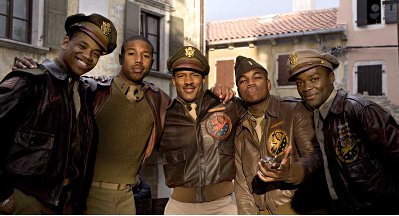
Confession time, everyone. Time to let you all know that, despite barely mentioned it, I’ve spent the last seven years of my life dreading the release of Red Tails. This dramatization of the Tuskegee Airman story – the story of an all-black unit of fighter pilots trained to fly and fight for their country at the eponymous air field in central Alabama – is one of the many, many, many passion projects George Lucas shelved back in the 90s so he could focus on making…well…you know…those movies.
But unlike every other reformed Lucasfilm fan in existence, my dread came with its own personal baggage. You see, this
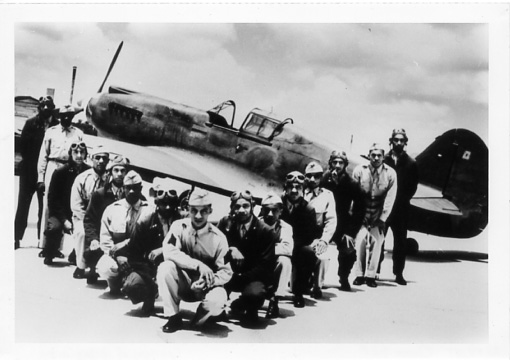
is a picture of my grandfather, Herbert E. Carter (eighth from the left, front and center), with his graduating class at Tuskegee Army Air Field in July, 1942. Thanks to racist foot-dragging within the War Department, it took ten months for his squadron to reach French Morocco. As the commanding officer of the Army Air Forces, General Hap Arnold, explained at the time, “Negro pilots cannot be used in our present Air Corps units since this would result in Negro officers serving over white enlisted men creating an impossible social situation.”
Eventually, after months of training at air fields throughout the American South, the Ninety-Ninth Flying Pursuit Squadron joined the North Africa campaign as part of the 33rd Fighter Group under Colonel William W. Momyer. That racist foot-dragging still prompts a font of righteous indignation in my gut, even though a part of me realizes all that retraining was instrumental to the Airmen’s future success. As with so much else, a fighter pilot’s chance of survival increases in proportion to the amount of training they have prior to combat. There’s a maneuver in this movie that one of the main characters supposedly learns from watching German pilots, but that’s some ol’ bullshit right there. They learned that trick before they even got out of Basic and spent the majority of 1942 practicing it, and a whole lot else besides, in the skies over Florida.
Once they finally made it Over There, the Ninety-Ninth scoured the Mediterranean for Axis craft, clearing the way for the the Allied invasions of Sicily and Italy. Two planes were shot out from under my grandfather during the invasion of Anzio, but he had no trouble securing others. On top of being a pilot, he was also the squadron maintenance officer, personally flight testing whatever his crew fixed so he would know the job was done. The Tuskegee Airmen would go on to support the Allied invasions of France and Germany, but my grandfather returned to the U.S. in July, 1944, having survived seventy-seven missions. Here’s a picture of him astride the German motorcycle he captured in Sicily and fixed-up for getting around:
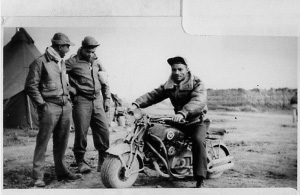
The point being, he’s a real person. So real he just helped me fact-check these last few paragraphs over the phone. This article from the Alabama Heritage website, or this article from CNN.com, will tell you more about the Tuskegee Airmen in a handful of minutes than this entire two hour movie.
And I’d much rather talk about all that than talk about the movie anyway. Even its positive reviewers can barely work up any enthusiasm for it. As far as I can tell, this movie’s only real defenders come from an increasingly vocal segment of people who actually like…those films…and who wants to get in bed with that crowd? Not I, said the cat.
At best, Red Tails is a perfectly serviceable War Movie from the 1950s that just so happens to be premiering in 2012. By which I mean it has all the problems of classical War Movies: too many characters, not enough time, and an overwhelming emphasis on building up to the mandatory minimum three action sequences.
If I had to pick a John Wayne movie this film most closely resembles (because when it comes to War Movies from the 50s everyone goes for John Wayne movies), I’d pick Flying Leathernecks…which I see Red Tails’ executive producer and re-shoots director, George Lucas “studied in preparation for this film.” I swear I didn’t look that up on the IMDb beforehand: my brain made that connection as I walked out of the theater. So either my brain surfs the internet while I’m asleep or the resemblance is just that obvious.

First of all, Red Tails starts the story in the wrong place: Ramitelli Airfield, Italy, 1944. When the “hard” part (convincing the US Army that African-Americas were, in fact, smart and coordinated enough to serve their country) is already over. Actually, the movie begins with a disparaging, racist quote from a 1925 Army War College Study of “Negroes in combat,” which pronounced us unqualified for a whole lot of things, flying planes being the least of them. You’d think this film would open in the Jim Crow South whose culture produced such a “study”…but no. If it did, we’d have to wait even longer before we got to our dogfights.
In case you haven’t noticed, George Lucas loves him a good dogfight. He loves machinery in motion. He loves old cars, old planes, new types of camera equipment, and making movies from the comfort of his chair like some beached walrus…no! Bad critic! Strike paragraph, begin anew…
I’ve got a lot of respect for George. (No, really, stop laughing. I’m being serious.) He’s been one hundred percent upfront about his reasons for making this film. He loves him a good dogfight and he loves telling stories about small groups of people changing the history of their world…or their galaxy. The only real differences are differences of scale. As long as they ride sweet machines while they do it, George Lucas will be there. And he’ll find a way to stick a camera into that machine’s fiery remains.
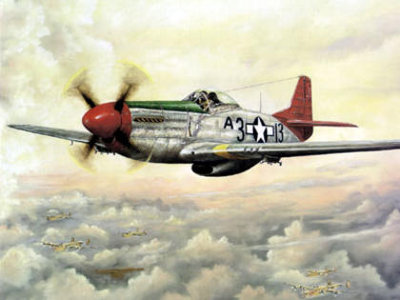
On this we agree: the P-51 Mustang is one of the sweetest fighter aircraft to ever roll off an assembly line. Can’t go wrong with a Rolls-Royce engine, can you? Add the distinctive coloration, which does exactly what it was designed to do – be distinctive – and you have all the ingredients for some extremely attractive pictures. George recognized this and so we have this film, because at some point George stopped being a director and started being a human Xerox machine.
And it’s…not bad. Let me repeat that with conviction:the movie isn’t that bad. But you should check it out for yourself because in the end it’s just…okay. And that almost makes me even more angry. There’s a part of me going, How dare anyone make a movie about my grandfather that is anything less than awesome? and I’m not the kind of critic who suppress feelings like that. Nor do I suppress the part of myself that loves the sight of a fiery explosion in a clear blue sky. It’s like a hole punched in the universe with flying metal. It’s awesome in the old sense of the word that lives a few doors down from awful. Not awful like those…other movies…but in the sense that War is Hell. And with movie making technology being what it is these days, the right director can find a way to plop you in the center of a flying hellscape.
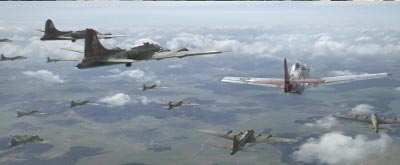
So I get it, George. And I thank you and your hand-picked director, Anthony Hemingway, for having the discipline to compose your shots well (I always knew what was going on no matter the ambient level of chaos) and for including as much carnage as a PG-13 rating allowed. It’s not nearly enough (I’ve seen worse third-degree burns on CNN) but that’s how I’d sum up this film as a whole. Where’s the rest of it, guys? I felt like I wandered into the middle of a story that didn’t end so much as stop…an experience I haven’t had with a George Lucas-aligned movie since Episode IV – A New Hope.
You know how almost everyone in a George Lucas movie is a cardboard standie with lines, save the three or four core characters who retain the camera’s focus? Such is the case here, where our cast extends to Marty ‘Easy’ Julian (Nate Parker), Joe ‘Lightning’ Little (David Oyelowo), Ray “Junior” Gannon (Tristan Wilds) and Colonel A.J. Bullard (Terrence Howard). There are other people in the film, some of whom you might even recognize, but they’re not really in the movie in the same way half the characters in your average X-Men movie aren’t really there, save to stand around and be counted. Yes, that’s Andre Royo as Squadron Maintenance Officer Antwan “Coffee” Coleman, who is not playing my grandfather any more than any of the others. None of these people are real, obviously. This story (as it says right in the opening) is “inspired by true events.” Which means “we took real events and replaced all the real people who actually participated in them with instantly recognizable War Movie stock characters.”
The first two I mentioned above are old friends, with Easy being the Serious Squadron Leader and Lightning his Hotshot, Upstart wingman who is (of course) “the Best Damn Pilot We’ve Got.” Despite being saddled with stock characters, Parker and Oyelowo turn in wonderful performances, doing a great job playing off each other as Lightning’s hotheadedness and Easy’s on-duty drinking strain their friendship. They deserve a movie all to themselves, but they have to share this one with at least three other plots. Colonel Bullard and Major Emanuelle Stance (Cuba Gooding Jr.) have to fight the good fight back in Washington and keep the racist top brass from shutting everyone down before we get to our first dogfight. Junior (who secretly longs to be called “Ray-Gun” and carries a Buck Rogers Special for just that reason…and as a personal good luck charm) has to go down behind enemy lines and participate in a ten minute remake of The Great Escape. And Oyelowo has to fall in love and marry a beautiful Italian woman named Sofia (the beautiful Bostonian Daniela Ruah).
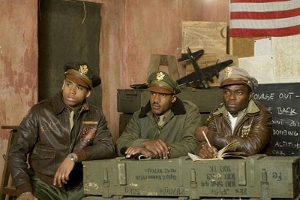
All these plots would be fine if it didn’t have to fight each other for running time. The amount of material here could fill a six hour HBO miniseries and still have enough story left over to keep the thing on air for years. Call up Steven Spielberg sometime, George, and ask him for a few pointers. Better yet, get him to direct the next movie. I know you say you’re making a sequel (and a prequel) but everybody says that once their movie hits theaters. I know nothing’s set in stone yet.
Spielberg’s no great shakes at the multi-character War Drama either. But (before you send me angry mail for that comment) he compensates for this by focusing in on one character and using that character to guide the audience through his brightly-light, hyper-real, high-pro-gloss nostalgia worlds made from pure Love of Cinema…and its power to arrest audiences with images.
Sometimes we call these characters “protagonists” and Red Tails gives us four for the price of one…five if you count Cuba, though he only shows up about halfway through. And it’s fairly obvious his and Terrance Howard’s characters were last-minute insertions into the picture. They have meetings, they make speeches, and just when you think you’re about spend some time with them – jump cut back to Italy, where we rejoin our four main plots already in progress.
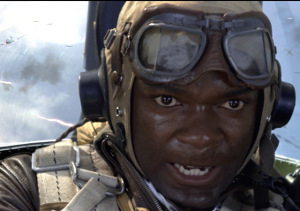
Because there are so many characters here, and because their stories take such divergent paths through the chaotic clusterfuck of war, all of them come off flat and far too bland to be anything other than human collages. One dimension’s supplied by the actors and their naturalistic interactions, the other’s supplied by those few bits of non-operational dialogue the script, courtesy John Ridley and Aaron (“I am the stone that the builder refused”) McGruder, supplies whenever our boys get down time. The non-speechy parts of this film are perfectly fine. We’re watching young dudes give each other shit, which is always funny. There are moments of actual brilliance scattered throughout, like pieces of an exploding train you find stuck in your plane’s belly.
Like this scene: Our Core Group is in town for the night, just moseying along to the dance hall, when some white officers approach them and ask if they’re the Red Tails. Our Core Group instantly quits their clowning, quiets down, and draws close to each other. Mutual protection and all that. The White Officer assures them that he’s a member of the heavy bomber group the Red Tails have just successfully escorted, and he just wants to thank them the Army way: “First round’s on me.” Our Core Group hesitates and someone (maybe Hemingway, maybe Lucas) does a very slow, very subtile push-in on them and the silent glaces they throw each other. If you know anything about how American racism worked at the time, you can see each man’s eyes ask “Is this a trap?” The punch-line being it isn’t. The white officers really do just want to buy Our Heroes a drink and say thanks. This should be a dramatic high point for everyone. If the story started out in America it would’ve been. But then we’d have to follow one story, centered on an actual character, for the entire film. Instead we follow four, which forces our directors to slice off each scene just as things are about to get interesting.
And I think you can all guess who’s going to die by the end anyway, so there’s two stories right there. Go back to the War Movie formula. You have to kill someone early on so we can show the audience War is Serious Hell. And you have to kill someone in the end to give the proceedings that proper, tragic note. What better excuse to cut to a mournfully billowing American flag? And hey – if one of your characters (the one who kept disappearing for twenty minute stretches) just so happens to make it back from that POW camp right then, at the group’s most perfect moment together…so much the better, then. More convenient that way, don’t’cha know?
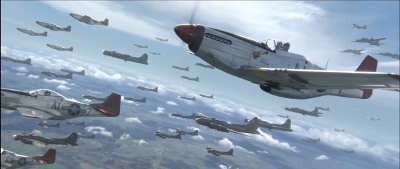
On the one hand, dogfights are awesome. On the other hand, the characters participating in them are not. Except for our two leads, who are busy having a falling out whenever Oyelowo can tear himself away from Daniela Ruah. Not that I blame him. Those two deserved their own movie too. Nobody in Italy had even heard of Jim Crow and they genuinely did view the Americans – whatever their skin tone – as liberators. These two would’ve risked life and limb walking down the streets of any major American city in 1944. But in Italy, they can get married…in public…with her mom’s blessing. Though the fact neither one knows a lick of the other’s language probably helps their relationship mightily.
But then again, dogfights are awesome. There are three major engagements in the film and each arrives right on schedule, punctual as the scar-faced German fighter pilot who pops up every once in awhile to sneer. (I couldn’t help but hum John Williams’ Imperial March whenever he and his plane appeared.) If you’re allergic to greenscreen this movie will swell your tongue right up. I’m not particularly, so I loved the special effects reel just as much as I expected. However, as with previous Lucas movies, I walked out wishing the movie part of the movie had been just a little bit stronger.
![]()
![]()
![]()
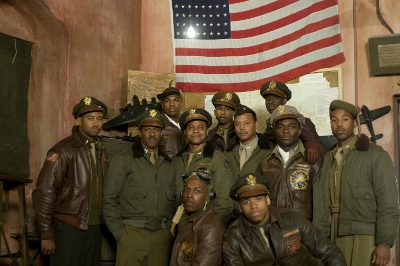

This is a fantastic piece. Great job.
Thank you, Carol.
Yes, thank you David. I too wished for more movie-fewer characters, better developed. But the flight scenes were wonderful. Lucas put me in the pilot’s seat. Ten year olds will love it. Too bad it’s just too complex a story to be told without the history lesson. Maybe it’s enough to spark curiosity about the real airmen and their real accomplishments.
One, let me echo Carol-great piece.
Second, I’m a big fan of Flying Leathernecks as a big ole, rote, late 1940s/early 1950s war film. Nothing special but a competent example of the genre with a good cast. So in a weird way your review makes me want to see this film because a big budget version of that with classy FX could be fun. The sad thing is, I’m pretty sure George has enough clout in Hollywood (or personal fortune) that if all he wanted was to remake that movie, he could have (or, better, a Star Wars or Raiders style drawing upon the best elements of a genre, then adding in modern production values and care and imagination). Why attach such a project to a true story that begs to be told well.
Wasn’t there a cable movie or mini-series about the Airmen made in the 1990s? Was it any better?
There was indeed an HBO movie from 1995, which I haven’t seen in years…and have to watch again, now. Pretty curious about that question myself. Luckily I have several copies readily available, so you can probably look forward to that in the future. I can tell you this much: it had the virtue of starring Laurence Fishburne.
And you should see it on the big screen before it”s gone, because the other thing I’ll give Lucas is this: he uses the whole fucking frame. And unlike all the asshat hacks who’ve tried to imitate him for years, he uses it well. Which makes sense, since George has always been the painter of his group. And the directors he hires are almost painfully “visual.” That’s the one thread that really runs through The Young Indiana Jones Chronicles. Hemingway’s TV roots actually help here, since he’s so used to a TV-framing he gets way closer to all his actors than anyone every got to John Wayne. The whole thing’s designed for a 40 foot screen and will probably wind-up looking over-polished and flawed on a home set-up. Especially the special effects, which have suffered more from the rise of digital TV than anyone, save the under-age workers who assemble our TVs…but that’s a whole ‘nother rant.
Point being, on the big screen George gets the maximum amount of space for his ‘xplosions and Hemingway gets to turn everyone into Amazing Colossal Men (and Amazing Colossal Daniela Ruahs). Everybody’s (supposed to be) happy. Now that I know about your appreciation for Flying Leathernecks I have to say you’re probably closer to this movie’s target audience than I am.
Well, the thing about appreciating old war movies is that while I enjoy them, I’m pretty disappointed when a modern filmmaker apes them, generally. More importantly this story deserved better than that.
Very awesome that your grandfather was one of the originals!
I’ve certainly always thought so. Growing up with living history is nice. Helps me take the long view and keep things in perspective…or so I hope.
Wow! Mr. DeMoss. How fascinating is this…my relative was in the same graduating class as your grandfather. He is the third person from the top (on the upper right side). His name is Faythe Andrew McGinnis (named after my great grandfather). Unfortuntately, he died a few months after graduation and the day before his wedding. If you could tell me more …I certainly look forward to hearing from you.
Thank You
Thing is, there’s not that much more to tell. My grandfather stayed in the Service until the middle-50s, flying everything up to and including the early F-4 Phantoms. He’s been to Mach 2, looked over the top of the world, and could’ve been an astronaut if he were five years younger and four inches shorter. Thankfully, he raised my mother in between doing all of the above. And so, here we are.
This is a long shot, I’m helping my boyfriend research his family history and Faythe A. McGinnis is also a relation of his, trying to fill in some blanks in the family tree, not even sure how we could reach each other, but would love to be able to connect and share information, I know you wrote this comment over 2 years ago but I just had to try.
Hi MiMi. I am also a relative of Faythe McGinnis. He was my grandfather, Charles McGinnis’s, brother. So he was my great uncle. I have been so fascinated with this story, and learning more about my family. I would love to connect with you.
One of these days somebody will really tell the story of the Best Goddamn Pilots This Country Has Ever Produced. Until then, well, as flawed as Lucas’ movie is (and also the HBO special way back, which started out okay but eventually morphed into God Is My Co-Pilot) at least there’s something to let the willfully ignorant US of A learn a little about these guys.
And tell your grandfather that should we ever meet he’s gonna see the best salute that I can remember how to snap off.
Thank you. I’ll do just that.
Great review sir, and I felt much the same. My dad is a surviving Tuskegee Airman who is active with the national organization. As a former journalist I too wondered whether the Lucas project would be a bit more accurate than the original HBO movie which did failed to reach out to the airmen in terms of accuracy. When Red Tails missed its original distribution date we began to think that perhaps it was flawed forcing the director to reshoot scenes or to introduce new characters. When it debuted we were there with a contingent from the Air Force and two reporters who where the to get my father’s reaction. While he gave it seven of ten stars, I think that we both felt it fell far short of both the hype and our expectations in general.
As you know the story of the 322nd is a rich part of American history and as you wrote it would be impossible to present it all in the span of two hours. The pilots and ground crew of the unit represented a diversity of the black community hailing from all corners of the country, with members from different economic and educational backgrounds. wish they could have taken the time to more fully develop the characters in the movie and given up some of the “Germans, let’s get ’em!” dialogue and flight sequences. Perhaps the intended audience is 12-15 year old boys who know little about the TA, and they felt the CGI was necessary to appeal to them. If that is the case then they really missed the boat. I co-produced a short documentary to supplement my dads presentations and last week we were invited to speak before 150 middle schoolers in NH. Let me tell you few of them have seen the movie, but they were anxious to learn more about training in Alabama, time at Selfredge, MI, the convoy to Morocco and of course the squadrons time in Italy.
My only hope is that this movie generates enough revenue at the box office, and through DVD sales to allow the prequel and sequel to be made, relying on different directors, as Lucas has suggested. Perhaps that will allow a more accurate telling of the the story of the Tuskegee Airmen and the positive impact they had on our nation!
I’m fairly certain the old guard are concealing their disappointment in the name of being civil, and I envy them that ability. As one of millions who spend the first five years of the 21st century learning an object lesson in Lucasfilm’s inability to make decent movies, it’s not an ability I share.
I found my lack of faith rewarded beyond measure. Forget the twelve-year-old’s – they’re unfairly maligned anyway. Think about the eleven, ten, eight, seven-year-olds. Or whatever the ideal customer of a Big Box, retail toy store might be in your neck of the woods. That’s Lucasfilm’s target audience – has been ever since George built his castle out of Star Wars toys. The movies are almost an afterthought at this point, only a few mutations away from becoming an appendix. I’m sure he’d do away with them completely if his involvement with them didn’t guarantee press coverage. He doesn’t even have to call “Racist!” on Hollywood or anything – he can’t sneeze on a digital monitor without someone recording it somewhere.
Honestly, the possibility of a Lucasfilm-produced “Red Tails Trilogy” terrifies me. The results will more than likely be disastrous, and just as likely to be ignored by everyone apart from nerds, talk show hosts and movie reviewers. (Excuse the redundancy.) Long gone are the days when anyone within George’s range of focus would dare question him or his filmmaking decisions. Even Spielberg seems to have given that up, despite the fact their legendary arguments produced some of the best movies of the 1980s. Indiana Jones’ original trilogy was born out of conflict and compromise. Every post-Phantom Menace film on Lucas’ CV was born from comfort, security and astonishing piles of wealth.
George is a kid who never gave up his dreams, and modern special effects allow him access to a playset the size of his imagination. He really does love dogfights that much, and if you removed them you’d remove his ultimate reason for making this film in the first place. At the same time, he’s fighting a decade-long Cold War with James Cameron over who’s going to go down in history as the guy who really revolutionized the movie-making technology of their age, and who really made the highest grossing movie(s) of all time. That’s where Avatar came from, so you can see George firing back with his Episode I re-release. Personally, I enjoyed seeing it go over like a lead balloon.
So I look forward to a sequel filled with even more dogfights and even less character development. Around here we like to call it “the Attack of the Clones effect.” As for the threatened prequel…well, we’ll see. It’s fun to imagine Spike Lee trying to negotiate a contract with George.
Might be the best thing in the world for both of ’em, now that I think about it. In any case, thank you for adding your voice.
My grandfather was James T Wiley. Thanks so much for this
You’re more than welcome. We’re all in this together.
CGI laden BUT badly done. It’s like watching old keystone cops sped up – planes of that era do not fly like that! Terrible script, and I really do mean terrible. Smaltsy American patriotism of the highest degree – I persevered only to see if it got any better. I can’t stress enough that 2 hours of your life will have been wasted watching this drivel. Lucas wants his head seeing too. DO NOT RENT OR BUY – you have been warned, I can do no more. How can so much money and effort go to such waste?
I think “to see if it got better” was the only reason my theater remained seated. I know for a fact it was my only reason. Besides dumb pride. I sat through all three of Lucas’ previous exercises in insult, and I told myself, “I’ll be goddamned if I admit defeat to this.” Honestly, it was a double disappointment – not good enough to be…well, good; not bad enough to be funny.
Doing a little family research and saw my namesake and Great Uncle Langston Caldwell listed in the class photo with your grandfather. Thanks
You’re quite welcome.
My great uncle was Faythe A. McGinnis. He is third from the right, in the picture you posted. This is a great read. Thank you!